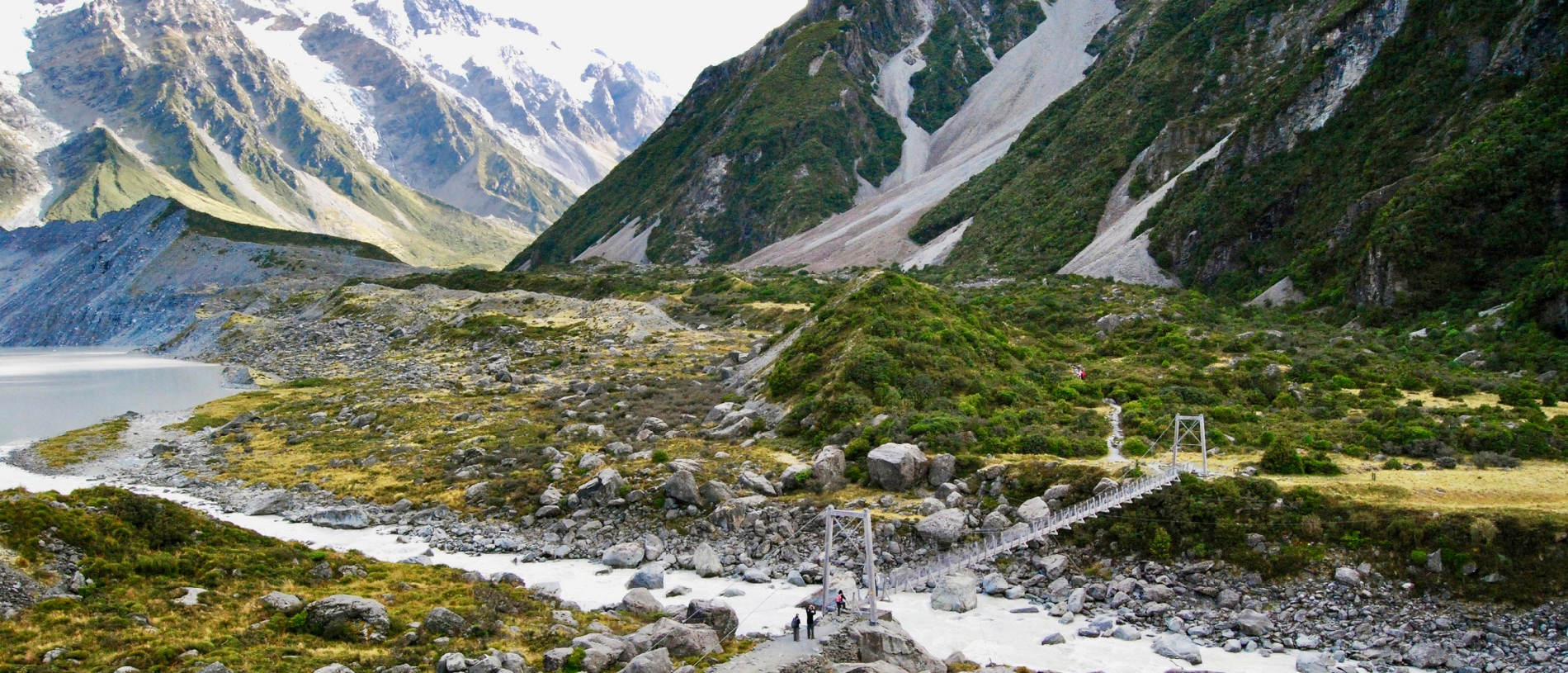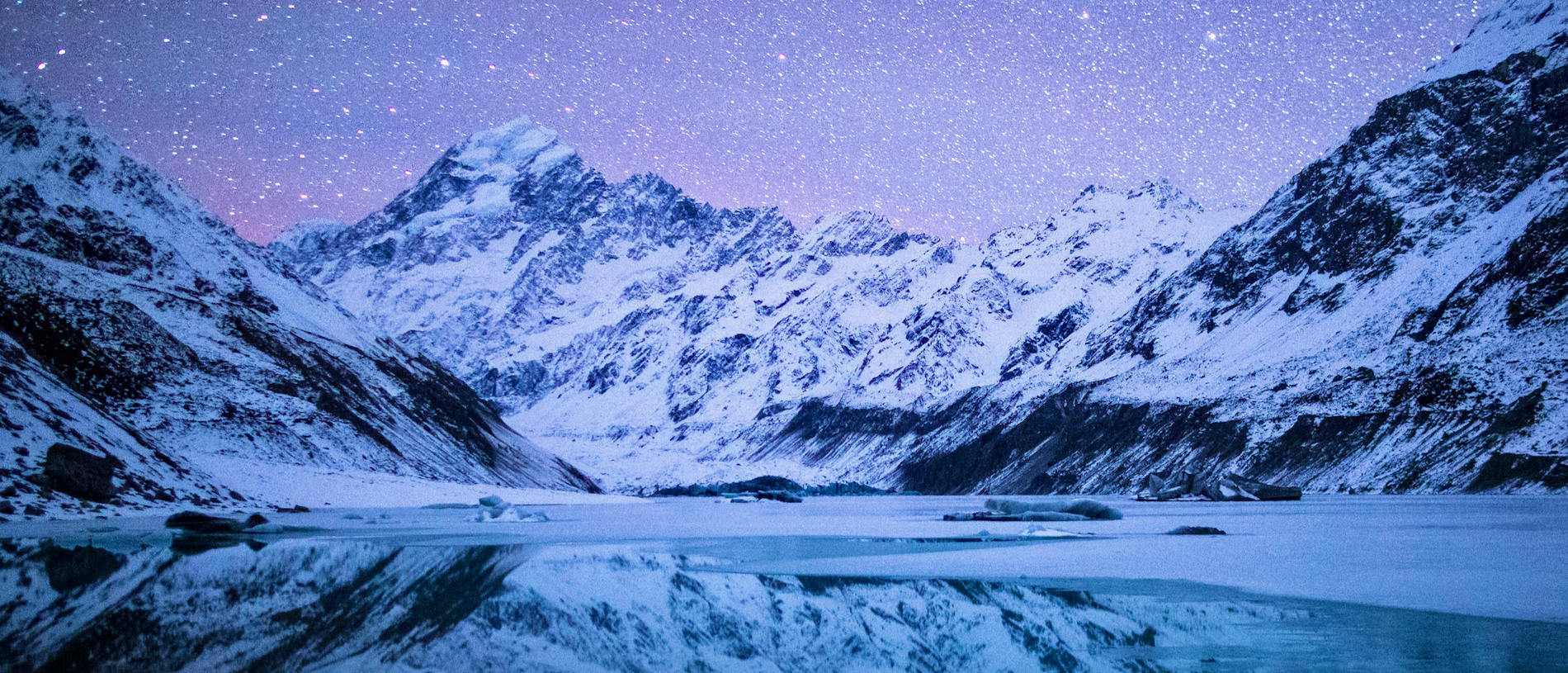
Aoraki Mount Cook Village walks
There are several fantastic walks around the village that provide views of Aoraki Mount Cook and the surrounding native alpine bush.

Aoraki Mount Cook National Park is a rugged land of ice and rock, with 19 peaks over 3,000m, including New Zealand’s highest mountain, Aoraki Mount Cook (3,754m).
This park is home to the mountain where legendary climber and all-round good Kiwi bloke Edmund Hillary honed his skills, before taking on the highest peak in the world. The sheer grandeur of the landscape will take your breath away, as you explore an alpine wonderland of rock and ice.
The Māori name for the mountain is Aorangi or Aoraki, meaning cloud piercer. (The difference in names is a pronunciation difference between iwi – the local Ngāi Tahu pronunciation is Aoraki.)
And, contrary to popular belief, Captain James Cook didn’t name the mountain after himself. In fact, it was not until 1851 that Captain JL Stokes, sailing down the West Coast, gave the mountain its European name, in honour of Cook.

While the park is now popular with climbers, to Ngāi Tahu Aoraki represents the most sacred of ancestors. According to legend, Aoraki was a young boy in the canoe Te Waka a Aoraki, which became stranded on a reef and tilted to one side. Aoraki and his brothers climbed to the high side of the canoe and sat on the wreckage. The south wind froze them and turned them to stone, forming the peaks of the Southern Alps Ka Tiritiri o te Moana.
Ngāi Tahu believe it is not appropriate to climb onto what is effectively the head of an ancestor, yet European immigrants and visitors alike have come to the area from the earliest times of settlement with the intention of climbing the unclimbed. The stories of their adventures are the stuff of legends – especially given the primitive equipment available to these early climbers.
The first attempt to climb Aoraki Mount Cook was made in 1882 by an Irishman, the Reverend WS Green, and two Swiss guides. Although his party climbed to within 200 m of the top, it was not until 1894 that the summit was reached, by three New Zealanders: Tom Fyfe, Jack Clarke and George Graham.

Today the park is recognised as one of the finest mountaineering areas in the world, for both experienced and novice climbers. For less skilled adventurers, there are plenty of great smaller mountain walks that lead to alpine tarns, herb fields and exquisite glacier views.
Aoraki Mount Cook is also home to the Tasman Glacier, New Zealand’s largest and longest glacier. It’s 27km long and up to 3km wide and slowly carves the valley sides, as it has done for millennia. Sediment from the glacier-ground rock creates opaque, milky lakes, and the flat valley floor provides a landing place for small planes and helicopters.
Guided ski trips, suitable for intermediate skiers, can be taken down the glacier. Helicopters and ski-planes have access to the park’s glaciers, too. From October until May, you can also explore the Tasman Glacier’s terminal lake on a boat trip.
Far from the lights of a city, the stargazing here is spectacular.
Aoraki Mount Cook National Park forms the majority of New Zealand’s only International Dark Sky Reserve, the largest reserve of its type worldwide.
From the telescopes at the Hermitage Hotel, you might catch a glimpse of Saturn’s rings, Jupiter’s moons, the Magellanic Clouds and other constellations. You can start your evening at the purpose-built planetarium at the Hermitage, before venturing out to see an amazing sparkling display turned on by nature.

The park is a harsh land of ice and rock, and 40 percent of it is covered by glacial ice. There is virtually no forest in the park.
However, the environment is alive with the most wonderful alpine plants. Over 300 species of plants are found here, including many varieties of mountain buttercup (Ranunculus) and daisy tikumu (Celmisia). The famed Mount Cook lily, Ranunculus lyalli, is the largest buttercup in the world.
About 40 species of birds are found in the park, and perhaps the most distinctive of these is the kea, a mountain parrot well known for its mischievous antics. The only true alpine bird is the tiny rock wren pīwauwau, which survives the winter in high rock basins. However, kea, falcons kārearea and black-backed gulls karoro can be found soaring in higher areas.

The braided riverbed of the Tasman is home to the kakī black stilt, one of New Zealand's rarest birds.
The park is also rich with invertebrate fauna, including large dragonflies, grasshoppers, distinctive moths and butterflies. A black alpine wētā, known as the ‘Mount Cook flea’ is found above the snowline. The jewelled gecko lives in the region but is so secretive that it is rarely seen.